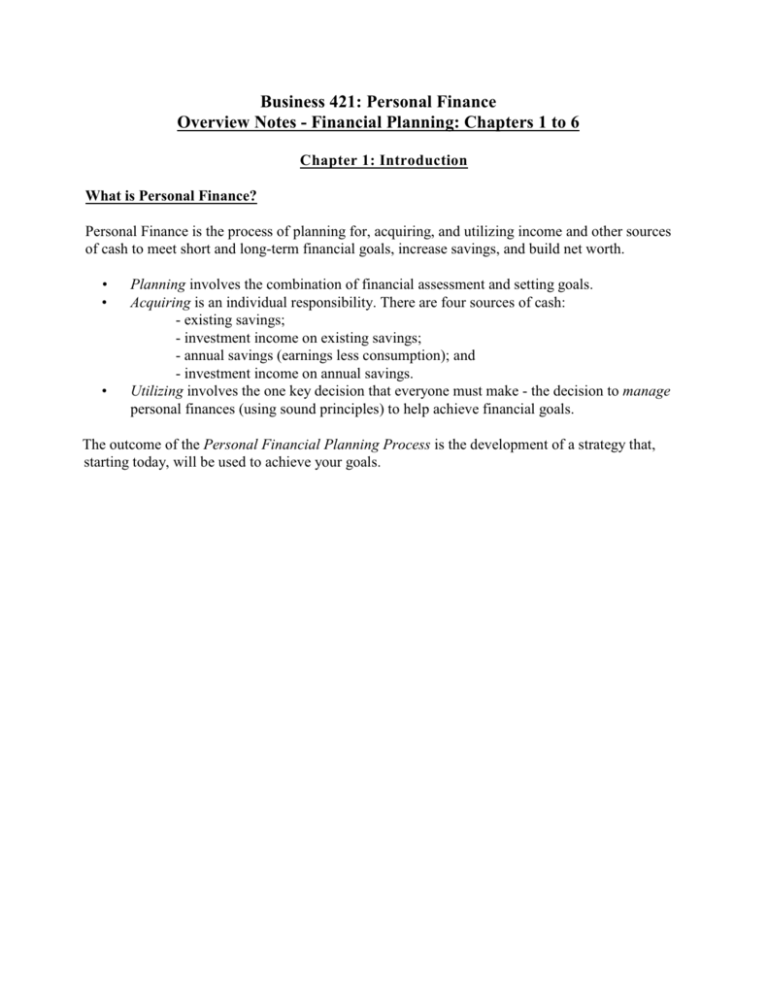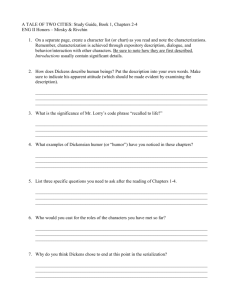Business 421: Personal Finance Overview Notes
advertisement

Business 421: Personal Finance Overview Notes - Financial Planning: Chapters 1 to 6 Chapter 1: Introduction What is Personal Finance? Personal Finance is the process of planning for, acquiring, and utilizing income and other sources of cash to meet short and long-term financial goals, increase savings, and build net worth. • • • Planning involves the combination of financial assessment and setting goals. Acquiring is an individual responsibility. There are four sources of cash: - existing savings; - investment income on existing savings; - annual savings (earnings less consumption); and - investment income on annual savings. Utilizing involves the one key decision that everyone must make - the decision to manage personal finances (using sound principles) to help achieve financial goals. The outcome of the Personal Financial Planning Process is the development of a strategy that, starting today, will be used to achieve your goals. Business 421: Personal Finance Overview Notes - Financial Planning: Chapters 1 to 6 Chapter 2: Time Value of Money Key Concepts: 1) Calculating Returns for a Single Period: r = [(P1 - P0 ) + D] / P0 where P = Purchase / Selling Price D = Dividend or Interest 0 = Beginning of the Period (Purchase) 1 = End of the Period (Sale) 2) Calculating Rates of Return Multiple Periods: a) Arithmetic Rates of Return - simple average of returns from multiple periods; b) Geometric Rates of Return - accounts for compounding effect when comparing returns over multiple years; = ((1+k)*(1+k)*(1+k)*….) = y Geometric Mean = y 1/n - 1 where ‘n’ = the number of periods ‘k’ = the periodic rate of return 3) Calculating and Comparing Rates of Return Within a Common Period: a) Annual Percentage Rate (APR) - conventional method of reporting rates which ignores compounding; b) Effective Annual Rate (EAR) - accounts for compounding effect within a one year period; - provides a basis for comparison when rates compound at differing frequencies / intervals; EAR = (1 + k j /m )m – 1 where ‘m’ = the number of periods ‘kj’ = the annual rate of return 4) Discount Rate - rate of return that is expected to be earned; - rate of return that equates money in different time periods; - rate is the rate that leaves an individual indifferent between present and future amounts; Business 421: Personal Finance Overview Notes - Financial Planning: Chapters 1 to 6 5) Opportunity Cost - opportunity foregone by taking one action versus another; - key concept in setting discount rates when analyzing investment opportunities; Consider that you can either spend or save your money. The opportunity cost concept is: The rate of return would you need to receive in order to not spend your money. The “pure time premium” = the price for waiting to consume. 6) Future Value - Reflects the value after accounting for compound interest. - Original Amount * (1 + interest rate per period) Number of Periods FV = PV * (1 + k) n 7) Present Value - Restates future payment(s) into today’s dollars by accounting for compound interest that would otherwise have been earned; - Future Value / (1 + interest rate per period) Number of Periods PV = FV / (1 + k) n 8) Annuities - Series of constant payments over time; - Ordinary Annuity (payments at end of period) vs. Annuity Due (beginning of period); FV of Annuity (Reg.) FVA = ((1+k)n –1)/k * Pymt where ‘n’ = the number of periods and ‘k’ = the discount rate FV of Annuity Due PV of Annuity FVA = ((1+k)n –1)/k) * (1+k) * Pymt where ‘n’ = the number of periods and ‘k’ = the discount rate PVA = [1-(1/(1+k)n]/k * Pymt where ‘n’ = the number of periods and ‘k’ = the discount rate - Constant Growth Annuity = series of payments that grows at a constant rate over time (Cannot use calculator - Use formula in Textbook pg. 31) 9) Factors Affecting Discount Rates a) Inflation - Use real discount rates for real (inflation-adjusted) cash flows; - Real rate of return Kr = [(1+Knom) / (1+I)] –1 where ‘I’ = inflation rate b) Taxes - Use after-tax discount rates for after-tax cash flows; Business 421: Personal Finance Overview Notes - Financial Planning: Chapters 1 to 6 Chapter 2: Time Value of Money In-Class Problems: Problem # 2-15 (Arithmetic Means vs Geometric Mean) Problem - Sheila Gilbert (Effective Annual Rates) Problem # 2-3 - Income for Life (Time Value of Money) Problem # 2-4 - Periodic Returns (Time Value of Money) Problem # 2-14 - Investment Options (Time Value of Money) Problem # 2-11- Perpetuity (Time Value of Money) Problem - Kay MacDonald (Time Value of Money- Real Rates of Return) Problem # 3-.6 - Jonathan Letters (Constant Growth Annuity) Business 421: Personal Finance Overview Notes - Financial Planning: Chapters 1 to 6 Chapter 3: Financial Planning Process Personal finance is the process of: Planning for, acquiring, and utilizing income and other sources of cash to meet short- and long-term financial goals, increase savings, and build net worth. Implementation of the personal financial planning process is the key element of personal finance and is the only way to ensure financial goals are achieved. The personal financial planning process consists of four steps: 1) Financial Assessment - What is your current financial situation? Involves compiling a Statement of Net Worth and a Statement of Cash Flows (Personal Income Statement) and analyzing these statements using ratio analysis. Also involves conducting a preliminary analysis of your most recent tax returns for tax saving ideas. 2) Setting Goals - Establishing what you want to achieve financially in both the short- and longterm. 3) Developing a Plan (Strategy) - Determining what will you do, starting today, to achieve your goals. 4) Controlling (Evaluating Progress) - Where are you in terms of achieving your goals? The implication of evaluating progress is that you must revisit the planning process again and again. Personal financial planning is not a process you complete once... rather it is ongoing. Your financial situation will change, as will your goals. Therefore your plan will change. This Personal Planning Process can also be illustrated as follows: Family or Individual S S S S S The financial strategy links the family to the environment Personal Circumstances/Factors Human Capital (Skills) Financial Resources (Assessment) Goals Risk Preferences - Financial Environment Economic Variables Tax Policies Financial Products Financial Institutions Financial Markets Given the family’s personal and financial situation and the current financial environment, how will their goals be achieved? The answers to this question lies in Strategy. Business 421: Personal Finance Overview Notes - Financial Planning: Chapters 1 to 6 Chapter 3: Financial Planning Process Goals: Goals can fall in one of four areas: 1) Lifestyle Goals associated with spending patterns (budgeting), housing (cost, size, type, location, contents, etc), vehicles, dependents (children), education, employment, travel, entertainment, and taxation, etc. 2) Financial Security Goals associated with savings, emergency funds, insurance, and retirement. 3) Debt Management Goals associated with current debt, future debt, and amounts of each, interest rates, reasons for borrowing, repayment (amortization) period, payment frequency, etc. 4) Estate Planning Issues like wills, living will, guardians for children, power of attorney, trusts, etc. Characteristics of a goal: Must have a time frame: short-, intermediate, or long-term [answers when]. Must be specific [answers what]. Must be measurable [compare to actual outcome]. Must be realistic [possible given current/expected financial circumstances]. Examples Formal Model of Financial Planning Wealth required at time N to = FV of current wealth invested + FV of savings for each period fund a specific financial goal for N period at return k%. t invested for N-t periods at k% Note: k% can be a nominal or real rate of return and St can be different lump-sums or an annuity. Business 421: Personal Finance Overview Notes - Financial Planning: Chapters 1 to 6 Chapter 3: Financial Planning Process Problems 1. You plan to buy a car in 18 months that currently has a sticker price of $18,000. Cars are expected to increase in cost by 5% over this period. You can invest money in the stock market, with a long-term rate of return of 12%, or in a GIC with a rate of 5%. You have no current wealth. How much must you save each month to have to have enough money to buy the car outright? You cannot save this much but you can save $325 per month. How much will you have to borrow to buy the car? If borrowing rates at that time are 7.5% for a two year loan, what will your monthly payments be? 2. Kay is 25. She plans to retire at age 55 and she desires a before-tax income of $50,000 real dollars per year in retirement. She expects to live until she is 85 at which time she wants to leave a $500,000 estate to her favorite university professor. She can invest money in the stock market, with a long-term rate of return of 12%, or in debt securities with an expected return of 7.5%. She expects inflation to average 5% over the complete period. How much money will Kay need at age 55 to fund her retirement goal? How much money will she have to save each year between now and age 55 to have this amount? Now also assume that Kay has $5,000 to invest towards achieving her goals. How much money will she have to save each year? . Business 421: Personal Finance Overview Notes - Financial Planning: Chapters 1 to 6 Chapter 4 and 6: Personal Financial Statements and Life Cycles The first step in the Personal Financial Planning Process is Financial Assessment; i.e. what is a family’s current financial position? To answer this question you must: 1) Compile personal financial statements: Net Worth Statement and Statement of Cash Flows 2) Analyze these statements using ratio analysis. The Net Worth Statement shows the families assets and liabilities at a point in time. Assets are divided into five categories: Cash/Near Cash; Investments: Registered ; Investments: Non-registered; Business/Property Investments; and Personal Property. Liabilities are divided into two categories: Current and Long-term. The difference between the two is Net Worth. The Statement of Cash Flows reports cash inflows and outflows for a period of time - usually a year. The difference is net cash flow; it will be positive (savings) or negative (need to liquidate investments or borrow). The ending period for the SCF should be the point for which the Net Worth statement is compiled. Some key points about completing personal financial statements: 1. A family is a group of people (the group could be one person) who share revenues and assets. By default this includes expenses and liabilities. 2. Compiling the statements is easier said than done. People know or can easily determine the big items. The "small" items take most of the time. See the sample financial statements (templates) on the course website. Use these templates to complete the statements. Modify them to fit the client. If an item does not apply, delete the row. 3. For the Net Worth Statement, value most assets at market value, however personal use assets should be valued at replacement cost (same as for insurance purposes). Personal use assets are associated with spending, a way of life, and debt. The values of these should not be overstated as it will inflate the estimate of net worth. Business 421: Personal Finance Overview Notes - Financial Planning: Chapters 1 to 6 4. Value liabilities at current amount owning. Use recent statements for information on investments, pensions, debt, insurance, etc. Recognize that net worth is not cash; it is usually not spendable (depends on the type of assets). 5. Human capital is not directly included on the Net Worth Statement, but is important when analyzing the family’s financial position and when lenders assess the family for credit purposes. 6. It can take a lot of time to collect/check the data and compile the statements. Use credit/debit card statements to track spending. Most families know or can easily determine the amount they spend on major items (mortgage, rent, loans, utilities, taxes, daycare, etc) but very few know how much they spend on "smaller" items (groceries, restaurants, snacks, drinks, entertainment, gas, toys, baby sitting, etc.) 7. For the SCF, check and re-check the data. Expect to revise the statement a number of times. Most people know the inflows, most underestimate the outflows. Note that the flow of income does not typically coincide with the payment of expenses. This implies the need for planning. 8. Designate expenses as either fixed or variable or as mixture of both. Define these and provide some examples of each. Savings should only include the amount actually saved by the family. Do not include contributions made by employers. Account for the savings on the net worth statement. 9. Ensure that the combination of (fixed expenses + variable expenses + savings) = 100%. Show the numbers used to calculate the spending and saving allocations. Analyze spending patterns highlighting opportunities for reductions. Remember that some deductions from salary are savings. 10. Analyze the family’s current financial position using a comprehensive ratio analysis. 11. The above process produces leads into budgeting. When budgeting, highlight areas where revenue increases and/or spending reductions are possible. Then budget in those areas. 12. As a family proceeds through the family life cycle, there may be a change in the level of importance of personal financial issues. Usually, however, all issues are important throughout in all phases of the life cycle; however, their relative level of importance may change. In-Class Problems: Problem # 1 - Vincent & Anne Crago (Financial Assessment -Personal Financial Statements)








